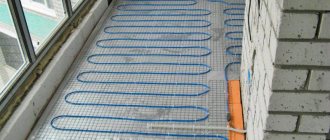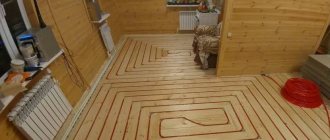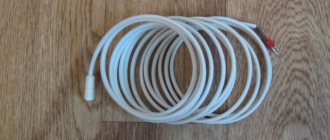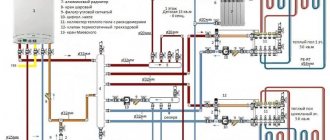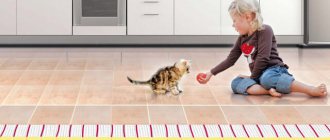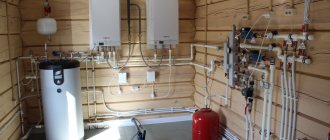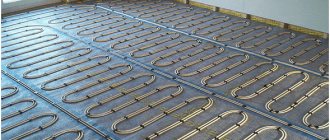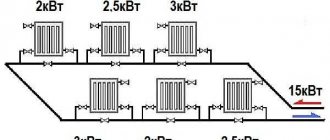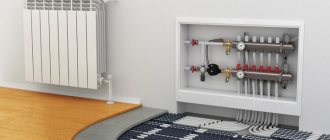Underfloor heating via pipes placed under the floor covering is becoming an increasingly popular way to heat a room or home. This method is of interest to both apartment residents who are faced with drafts, and owners of private houses who feel cold from the floors on the ground floor.
Heated water floors, the installation schemes of which in the apartment require a particularly responsible approach, are a wonderful addition to the central heating system. In particular, this type of heating has its advantages:
- Natural heat supply. For the human body, heating from bottom to top is the most comfortable. This is the direction that the water-heated floor in the apartment sets.
- Elimination of drafts. As a rule, air currents travel along the surface of the floor, unpleasantly cooling your feet. When using heating, this problem disappears.
- Possibility to insulate the wall. This means compensating for heat loss through those walls that face the street.
- Saving. Warm floors from the apartment's heating system allow you to maintain a comfortable temperature in the house, and at the same time do not greatly affect utility bills.
Despite all the advantages, it is necessary to take into account that the efficiency of this type of room heating directly depends on the thoughtfulness and quality of the installation. In particular, a lot depends on the pattern according to which the pipes will be laid.
Schematic representation of a water heated floor
Read on in the article about what you will need to install water floor heating in an apartment, how to carry out the installation and how to choose a pipe laying scheme.
Water-type underfloor heating: disadvantages
Before proceeding to a more detailed acquaintance with the features of such floor heating and the intricacies of the installation process, for the sake of objectivity it is necessary to mention its disadvantages:
- Price. Unlike other types of underfloor heating, water types are more expensive both in terms of the purchase of components and the cost of the preparatory stages.
- Difficult to install. The process of preparation, installation and final work can take more than a week. At the same time, a mistake made at any stage will be difficult to correct.
- The need to obtain permission. Installation of water heated floors in an apartment cannot be carried out without permission. The issue will be studied in more detail below.
- Problematic repair. If problems arise, to eliminate them you will have to completely or partially destroy the top of the floor covering.
In addition, for an apartment with centralized heating you will almost certainly have to purchase various special equipment such as a thermostat, pump, collector. All this is necessary for the correct operation of the system, in which the neighbors will not feel any discomfort.
Advantages
Heating a house with underfloor heating provides a number of advantages compared to classic batteries:
- The heated air does not escape to the ceiling, but stays near the feet, providing residents with complete comfort. This distribution makes it possible to save energy by reducing the overall temperature in the room by several degrees.
- Electric or water underfloor heating is adjustable. If necessary, it can be reduced to a minimum or disabled. Automated devices can operate on a timer.
- You can heat the floor covering in a separate room, for example, in a bathroom.
Bureaucratic obstacles: why can’t you install heated floors in your apartment without permission?
In order to install a heated floor in an apartment from central heating, the owner will need to obtain the appropriate permission from the competent authorities.
Without this document, of course, installation can be carried out, but such a system will be considered illegal, and if discovered, the owner will face a large fine.
There are good reasons for this condition:
- Durability of coatings. The floor in each apartment is designed for a certain load. If the heated floor in the apartment is water-based, then due to the thick surface layer, the ceiling systems may sag or begin to pose a threat to residents.
- Heat transfer. Since the heated floor from the central system takes water from a common riser, there is a risk that the supply will be disrupted and the heat will not fully reach the neighbors.
- Loss of pressure in the riser. One way or another, the warm floor changes the water pressure, making it weaker. Due to this, certain difficulties may arise.
The law classifies water heated floors in an apartment as redevelopment, so if an illegal connection is discovered, the owner faces not only payment for the energy spent on heating, but also a fine for illegal redevelopment of the premises.
Warm floors in a new building
Despite all the difficulties, it is still possible to obtain such permission. The easiest way would be for those living on the first floors with a top heat supply and for the inhabitants of the last floor with a bottom supply. From the point of view of utilities, a heated floor from heating in an apartment will not cause damage to the heating process and heat transfer if the water reaches it last.
The legality of installing heated floors in an apartment guarantees the absence of problems with inspection services and large fines. As an option, you can switch to autonomous or semi-autonomous heating. In this case, the only thing you need to worry about is thermal insulation so that the neighbors below do not heat up their ceilings.
Is it possible to install such heating: is it legal?
Obtaining permission to install water heating in an apartment building can be difficult. This is due to the fact that such heating is quite dangerous to operate due to the high threat of flooding of the lower floors.
Important
To get around all the obstacles, residents try to carry out installation by connecting the system to the heating risers. This is a gross violation of the law, so it is best to obtain official consent and act within the framework established by SNiP.
According to SNiP, the heating system of an apartment can be changed by connecting a water floor only if the modification is agreed upon with representatives of the housing and communal services and the heating network office. Such autonomous heating must be specified in the design documentation.
Official registration takes a lot of time and effort. But water heating that is completely made according to the standards allows you to safely and without problems use it legally, even sell your home without additional collection of documents and permits.
Warm water floor in apartments: how to connect
Before starting work on developing a laying scheme and installation, it is necessary to decide how exactly the heated floor will be connected to the central heating system.
Obviously, for residential premises the source will be radiators. When installing a heated floor in an apartment from a radiator, when laying pipes it is necessary to take into account the temperature distribution: near the radiators, the turns can be made sparser to avoid uneven heating.
In the case of a bathroom where there are no radiators, you can install warm floor heating in the apartment from a heated towel rail. Such a system will fit organically into the existing one and will not require major rework.
The warm floor in an apartment with individual heating is connected to the boiler. Of all the ones presented above, it is perhaps the most convenient.
Recommendations for use
It is important to remember that TPs are an inertial heating system. Therefore, noticeable changes in room air temperature occur several hours after adjustment.
Recommendations:
- Heating of the floor surface of residential premises should be maintained within 25–30 ºС. In the hallway, bathroom, along the outer walls, the temperature can be increased to 35 degrees.
- To reduce the shrinkage of the concrete screed, fiberglass and other fillers are added to the solution. The dosage is indicated on the packaging.
- It is necessary to add liquid in a timely manner, and also periodically monitor the heating temperature. The water transformer practically does not require additional maintenance.
The temperature control of heating circuits is usually done manually. But it is possible to install automation with a programmable controller that controls the thermostat servo drives and the pump. Such high-tech work should only be performed by experienced specialists. You can find out the warm floor in the apartment by following the link. Insulating the loggia floor you will find the answer in the link.
Prices for underfloor heating systems
warm floor
Connecting a heated floor to a central or individual heating system
Having figured out what you can connect the heating system to, you need to consider how this can be done. First of all, it is necessary to mention a number of additional equipment that should be used during installation:
- Unit pump. To ensure that water is evenly distributed throughout the system and does not linger anywhere, a pump is used.
- Air vent. With its help you can avoid air locks, which can often form in pipes.
- Pressure controller. It must be constant in the system. Sudden surges will, at best, lead to incorrect operation, and at worst, damage the pipes.
- Thermostat. With its help you can control the water supply and its temperature. Some models allow you to set start and stop times.
- Filter. It will purify the water, thereby increasing the life of the entire system.
Combs (manifold distributors)
Also, a water heated floor in an apartment from a heated towel rail, radiator or boiler must have a mixing unit. It is here that the water from the heating, which can reach more than 80 degrees Celsius, will be mixed with the return water. Due to this, the floor will have a comfortable temperature.
To better monitor the condition, you will need to install monitoring devices. In the case of connection to central heating, the permitting service may require the installation of a meter - this also needs to be taken into account.
Warm floors from hot water supply in an apartment, conditionally, consist of two parts:
- manager - this group includes all of the above devices;
- functional - the pipe itself.
As a rule, there are no problems with the installation of the first part - you just need to connect everything correctly. But the second part often causes difficulties even for experienced craftsmen.
Laying pipes from central heating
Direct installation of pipes: choosing a laying scheme
Regardless of whether the apartment has a centralized or autonomous water-heated floor, attention must be paid to both the material of the pipes and the method of their installation.
In total, three main patterns can be distinguished:
- snail;
- snake;
- double snake.
Images of circuits: snake, double snake, spiral
The heated floor in an apartment from hot water can be laid in a double spiral: the small one is located near the window or outer wall, and the second one is located directly in the room.
Double helix
From the point of view of efficient use of pipes, the snail laying method is the most preferable.
In this case, the laying takes place in a spiral, which ensures uniform heating of the surface. Its disadvantage is the difficulty during installation: correctly calculating the radius, pitch and at the same time taking into account the maximum permissible bend is a difficult task that is best entrusted to a professional.
Snake laying method
A snake and a double snake are not much different - in both, the laying goes in turns and the end of the return is located in the same place as the beginning. The difference is that in a regular snake the return circuit runs along the perimeter of the room, while in a double snake it returns parallel to the supply part of the pipe.
The downside of the snake is the noticeable temperature difference. The water gradually cools down, so towards the end of the journey the temperature drops noticeably, which leads to poor heating of the floor.
The number of pipes for a heated floor in a one-room apartment varies depending on its size, but there are many calculators online that allow you to calculate the length. If necessary, you can use the formula:
k – pipeline bending coefficient;
Slot – area of the plot;
Hstep – laying step.
Preparatory work before laying pipes
In order to lay a heated water floor in an apartment with your own hands, you need to prepare a base for laying pipes.
The main requirement is a flat surface, since even with a pump, tilting the pipes can cause the system to malfunction.
Most often, special leveling mixtures are used, as this is a reliable way to provide a stable and even base for a warm water floor. However, there are alternatives:
- profile mats;
- heat-conducting plates.
Profile mats are relief slabs in the recesses of which pipes can be placed. As a rule, their level is leveled by wooden logs. Also, as an additional means of distributing heat over the floor surface, the mat can be used as a base for heat-conducting plates - a means by which uniform heating of the floor is ensured.
Laying the pipe in a profile mat
They can also be used as independent units. The plates are placed on a leveled wooden structure, and pipes are placed in a special recess.
Thermal conductive plates
If a screed is not used, then thermal insulation is laid before installing the fastening systems:
- rolled foil insulation;
- polystyrene foam mats.
Some profile mats are already made of heat-reflecting material.
In any case, thermal insulation is needed to increase the efficiency of the system.
After the preparatory work is completed, the pipes are laid and fixed. To be on the safe side, you can turn on the system to avoid the risk of leaks or pipe breaks. If there are none, then you can move on to the final stage. From above, the entire system is filled with flooring mixture, after which it is waited for it to dry completely. Only after this can the warm water floor be turned on.
Selection of pipes for warm water floors
Regardless of whether it is planned to install water heated floors into the apartment from a boiler or from central heating, the range of acceptable pipes does not change. There are several requirements that they must meet:
- absence of seams and joints;
- corrosion resistance;
- flexibility;
- long term trouble-free service;
- immunity to temperature changes;
- the material should not expand when heated.
Most often, heated floors from a gas boiler in an apartment, as well as from radiators, are laid using cross-linked polyethylene pipes. Their main advantage is flexibility and resistance to temperature changes.
Another, no less popular type is metal-plastic. The advantages of these pipes include:
- ease;
- high heat transfer rates;
- sufficient flexibility;
- resistance to plaque formation.
Less popular are copper and corrugated pipes. Despite the fact that they are not inferior in quality to the leaders, their main disadvantage is their very high cost.
A little background
The very idea of insulating floors, as well as walls, by laying hot water pipelines inside them is by no means new. Back in Soviet times, experimental projects of panel houses were created and implemented, in which hot water circulated inside the floor slabs and walls, thereby providing apartment heating without radiators. It was believed that the absence of batteries saves useful space in rooms and does not spoil their aesthetic appeal.
Connecting a heated floor to a heating system
It is quite natural that such buildings have not stood the test of time, due to the almost zero maintainability of heating systems and extremely low economic feasibility. Indeed, most of the heat was not spent on heating the interior, but went to heat the structural elements of buildings and the surrounding atmosphere.
Channels made of iron corroded very quickly due to constant contact with water under pressure and at high temperature.
This publication is devoted to a description of floor heating systems combined with heating communications, as well as consideration of the nuances of installing heated floors.

